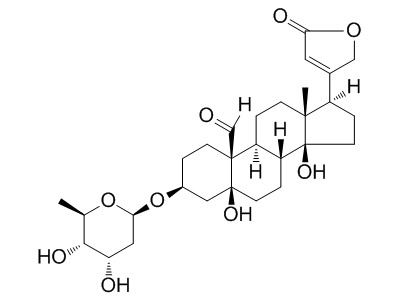Helveticoside
Helveticoside, disulfiram, and lanatoside C as potential molecular targets in chronic obstructive pulmonary disease( COPD).
Inquire / Order:
manager@chemfaces.com
Technical Inquiries:
service@chemfaces.com
Tel:
+86-27-84237783
Fax:
+86-27-84254680
Address:
1 Building, No. 83, CheCheng Rd., Wuhan Economic and Technological Development Zone, Wuhan, Hubei 430056, PRC
Providing storage is as stated on the product vial and the vial is kept tightly sealed, the product can be stored for up to
24 months(2-8C).
Wherever possible, you should prepare and use solutions on the same day. However, if you need to make up stock solutions in advance, we recommend that you store the solution as aliquots in tightly sealed vials at -20C. Generally, these will be useable for up to two weeks. Before use, and prior to opening the vial we recommend that you allow your product to equilibrate to room temperature for at least 1 hour.
Need more advice on solubility, usage and handling? Please email to: service@chemfaces.com
The packaging of the product may have turned upside down during transportation, resulting in the natural compounds adhering to the neck or cap of the vial. take the vial out of its packaging and gently shake to let the compounds fall to the bottom of the vial. for liquid products, centrifuge at 200-500 RPM to gather the liquid at the bottom of the vial. try to avoid loss or contamination during handling.
Am J Chin Med.2016, 44(6):1255-1271
Dent Mater J.2020, 39(4):690-695
Antioxidants (Basel).2022, 11(12):2496.
Nat Commun.2019, 10(1):5169
Synthetic and Systems Biotechnology2023, j.synbio.
Chem Biol Interact.2018, 283:59-74
Plant Physiol Biochem.2023, 201:107795.
Phytomedicine.2020, 153440.
Korean Journal of Medicinal Crop Science2018, 26(5):382-390
Pharmaceuticals (Basel).2021, 14(8):742.
Related and Featured Products
Lung, 2014, 192(1):87-93.
Protein-Protein Interaction Network Analysis in Chronic Obstructive Pulmonary Disease.[Reference:
WebLink]
The aim of this study was to investigate the gene expression profile of chronic obstructive pulmonary disease (COPD) patients and non-COPD patients.
METHODS AND RESULTS:
Microarray raw data (GSE29133) was downloaded from Gene Expression Omnibus, including three COPD samples and three normal controls. Gene expression profiling was performed using Affymetrix human genome u133 plus 2.0 GeneChip. Differentially expressed genes were identified by Student's t test and genes with p < 0.05 were considered significantly changed. Up- and downregulated genes were submitted to the molecular signatures database (MSigDB) to search for a possible association with other previously published gene expression signatures. Furthermore, we constructed a COPD protein-protein interaction (PPI) network and used the connectivity map (cMap) to query for potential drugs for COPD. A total of 680 upregulated genes and 530 downregulated genes in COPD were identified. The MSigDB investigation found that upregulated genes were highly similar to gene signatures that respond to interferon and downregulated genes were similar to erythroid progenitor cells from fetal livers of E13.5 embryos with KLF1 knocked out. A PPI network consisting of 814 gene/proteins and 2,613 interactions was identified by Search Tool for the Retrieval of Interacting Genes. The cMap predicted Helveticoside, disulfiram, and lanatoside C as the top three possible drugs that could perhaps treat COPD.
CONCLUSIONS:
Comprehensive analysis of the gene expression profile for COPD versus control reveals Helveticoside, disulfiram, and lanatoside C as potential molecular targets in COPD. This evidence provides a new breakthrough in the medical treatment of patients with COPD.
Journal of the Food Hygienic Society of Japan (Shokuhin sgaku Zasshi), 1998, 39(4):256-265_1.
Identification and Analyses of Main Cardiac Glycosides in Corchorus olitorius Seeds and Their Acute Oral Toxicity to Mice.[Reference:
WebLink]
METHODS AND RESULTS:
Two digitoxigenin glycosides (coroloside and glucoevatromonoside) as well as strophanthidin glycosides (erysimoside, olitoriside, corchoroside A and Helveticoside) were identified as main cardiac glycosides in the methanol extract of 'Moroheiya' (Corchorus olitorius) seeds. HPLC analyses revealed that C. olitorius seeds collected in Japan contained cardiac glycosides at the level of 0.1~1.0% (wet weight). Also, it was suggested that dark greyish green seeds contained more cardiac glycosides than dark greyish yellow~dark greyish yellow-green seeds.
CONCLUSIONS:
Gluco-(1→6)-olitoriside and olitoriusin which had been reported as the main cardiac glycosides by Mahato et al., were not detected by HPLC and 1H-NMR analyses. The acute oral toxicity of isolated cardiac glycosides was tested in male ddY mice (6 weeks of age). The LD50 values of a mixture of erysimoside-olitoriside (6:4), and a mixture of coroloside-glucoevatromonoside (1:1) were >500 mg/kg.
Further toxicity testing could not be carried out because the amounts of the cardiac glycosides isolated were insufficient.



